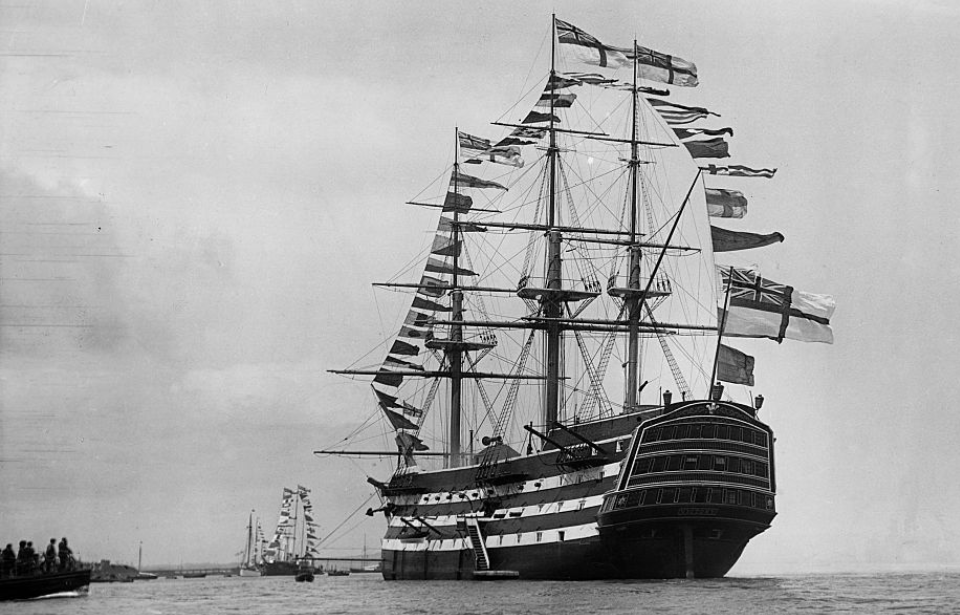
Photo Credit: Hulton-Deutsch Collection / CORBIS / Getty Images
At well over 200 years old, the HMS Victory is undeniably one of the most famous ships in the world. Serving as the flagship for Lord Horatio Nelson during the Battle of Trafalgar, she’s been well-preserved, despite her age, thanks to the dedication of British citizens numerous times throughout her past.
Discover the fascinating – and lengthy – history of one of the most incredible ships ever commissioned by the British Royal Navy.
Construction of the HMS Victory
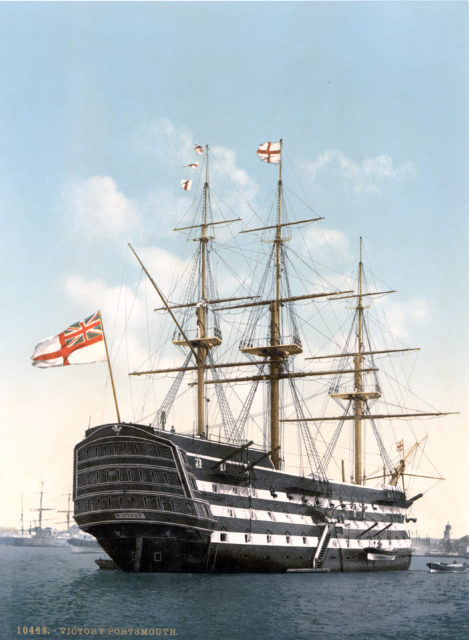
HMS Victory, 1900. (Photo Credit: Unknown Author / Wikimedia Commons / Public Domain)
The HMS Victory was built during the 18th century as one of 12 first-rate ships designed to carry at least 100 guns. Her keel was laid down on July 23, 1759, and she was given her name in October of the following year. The vessel’s frame was constructed by 150 workmen, who used the wood of a whopping 6,000 trees, the majority of them oak.
At the time, the Seven Years’ War was going in England’s favor, so there wasn’t a rush to complete construction. It wasn’t until May 7, 1765 that Victory was finally launched.
A few problems soon became obvious. First, the ship’s lower gunports were only 1.4 meters above the water, and she tipped slightly to the right. The latter problem was fixed, but it was determined that, if Victory was fighting in rough water, then the lower guns couldn’t be used, as they would flood the vessel.
As the Seven Years’ War was over by the time of her launch, Victory wasn’t put into service until the American Revolution, sitting for years in the River Medway.
HMS Victory‘s specifications
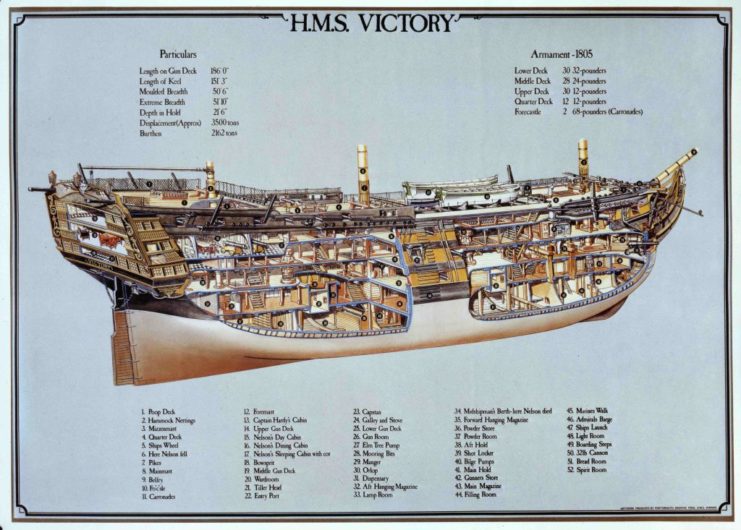
HMS Victory, as she was equipped in 1805. (Photo Credit: Photo12 / Universal Images Group / Getty Images)
The HMS Victory was certainly a sizeable ship at 227 feet, six inches in length – her gundeck alone measured 186 feet. Her depth of hold was more than 21 feet, with a draught of just over 28 feet. Arguably the most visually impressive feature was her sails, and it’s no wonder why – they totaled 6,510 square yards, allowing for a top speed of 11 knots. She could also hold a crew of roughly 850 men.
Victory‘s armaments changed throughout the years, though they were always made up of various cast iron cannons. Initially, she had thirty 42-pound cannons on the lower deck, twenty-eight 24-pound long guns on the middle deck, thirty 12-pound cannons on the upper deck, and 12 six-pound cannons split between the quarterdeck and the forecastle. The 42-pound ones were swapped back and forth with 32-pound cannons, depending on what was available at the time.
The HMS Victory makes a name for herself in combat
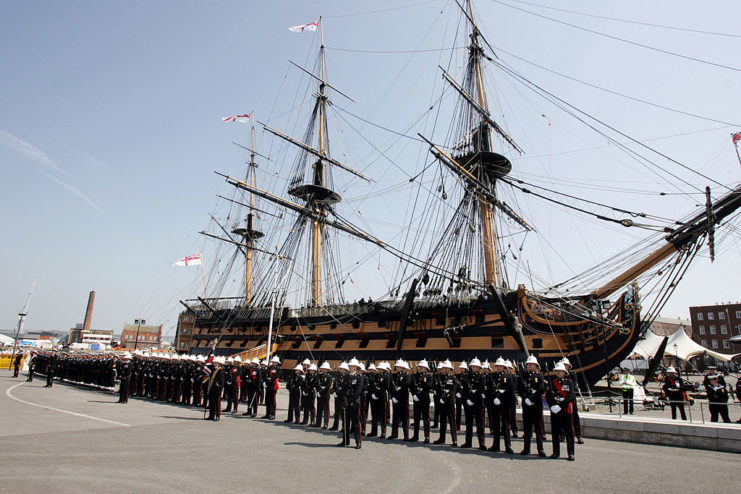
British Royal Navy sailors from the HMS Victory stand guard in front of the ship for the 200th anniversary of the Battle of Trafalgar, June 2005. (Photo Credit: Jamie Wiseman / AFP / Getty Images)
The HMS Victory quickly became known as an excellent vessel at sea, taking on the role of flagship for many well-known British admirals. She was used during the First and Second Battles of Ushant, the Siege of Gibraltar and the Battle of Cape St. Vincent.
Following this last engagement, she was sent back to England to be assessed for seaworthiness, and naval architect Sir Robert Seppings found Victory had significant weakness in her stern. As such, she was declared unfit for service and left in the Chatham Dockyard, until she was turned into a hospital ship for French and Spanish prisoners of war (POWs) in December 1798.
Ultimately, the decision was made to recondition Victory and bring her back into service, after the HMS Impregnable (1810) ran aground, leaving the British Admiralty without a high-quality, three-decked ship. As well as fresh paint, four gun ports were added, her magazine was lined with copper and the figurehead was replaced.
Lord Horatio Nelson
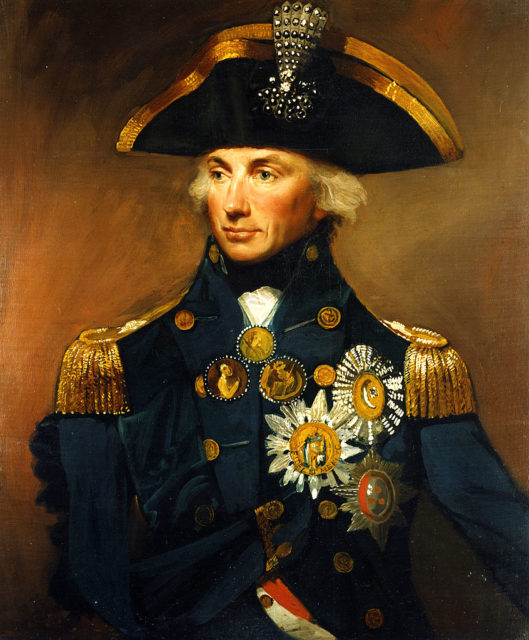
Lord Horatio Nelson, 1798. (Photo Credit: The Print Collector / Getty Images)
When her remodeling was complete, the HMS Victory was transferred to then-Vice-Adm. Horatio Nelson, who raised his flag on May 18, 1803, making Samuel Sutton captain. Nelson was the commander-in-chief of the Mediterranean Fleet and sent much of his vessels, including Victory, to blockade the French for 18 months. Under Adm. Pierre-Charles Villeneuve, the enemy ships escaped the British in March 1805.
The fleet gave chase, traveling to the West Indies. Nelson, aboard Victory, waited for them to leave Cádiz Harbor and sail into the Mediterranean. What ensued was the most famous of Victory’s engagements: the Battle of Trafalgar. It took place off of Cape Trafalgar against the same French and Spanish fleet the British had been chasing during the previous months.
Battle of Trafalgar
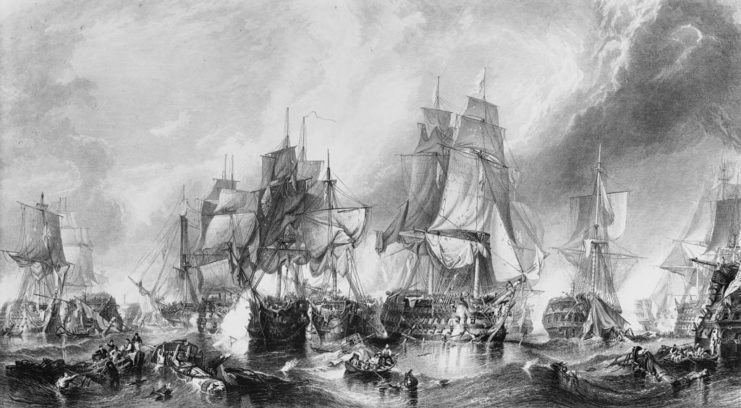
Redoutable (1795) engaging the HMS Victory during the Battle of Trafalgar, October 1805. (Photo Credit: Hulton Archive / Getty Images)
Before the battle broke out, Lord Nelson had the HMS Victory use flag signals to display his most famous line, “England expects that every man will do his duty.” He then commanded his fleet of 27 ships to separate into two columns, forging forward to break the enemy line. Although conditions weren’t quick, they were able to reach and engage the belligerents, with Victory taking on two vessels.
It seems only appropriate that the English flagship would be the one to take on her French counterpart, Bucentaure, as well as Redoutable (1795). Victory’s guns tore a hole in the side of the former, and the amount of cannon fire caused between 300 and 450 casualties aboard the French vessel.
A sniper positioned on the mast of Redoutable managed to deliver a fatal shot to Nelson, who died before the battle concluded. Trafalgar was a win for the British, however, and Nelson’s men carried the admiral’s body home in a vat of liquor.
The HMS Victory is taken out of the fight
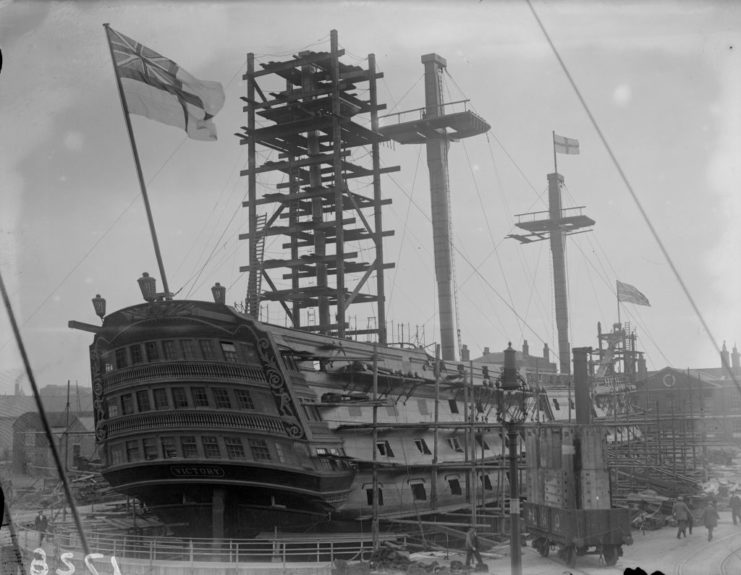
HMS Victory, 1926. (Photo Credit: Fox Photos / Getty Images)
The HMS Victory sailed for a few more years, to help with the British continental blockade during the Napoleonic Wars. Despite her impressive display at Trafalgar, the Admiralty decided she was too old to be used any longer. She was demoted from first to second-rate, and used as a troopship, a floating depot and, finally, a prison ship.
As her condition worsened, Victory was taken to Portsmouth Harbour, where she served as the flagship for the port admiral, a non-sailing role. By 1831, it was decided that her time had come to an end and she was to be broken up and used to repair other vessels.
This, however, didn’t sit well with the public. After significant discontent, Victory was opened to tours which, inadvertently, made her condition worse. On numerous occasions, she almost sank into the harbor, once because she was hit by the HMS Neptune (1874). Another was the result of the vessel springing a leak
Save the Victory Campaign
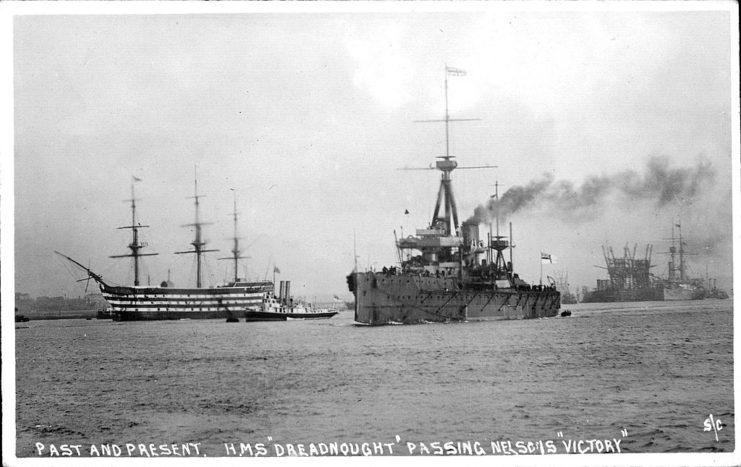
HMS Dreadnought (1906) passing the HMS Victory. (Photo Credit: Arkivi / Getty Images)
By 1886, the HMS Victory was in such bad shape that Sir Edward Seymour declared, “A more rotten ship than she had become probably never flew the pennant. I could literally run my walking stick through her sides in many places.” A few years later, another observer called her condition “nothing short of an insult.”
In 1921, the vessel was saved yet again by the public, who started the Save the Victory Campaign. Thanks to the outcry, as well as a sizeable donation from Sir James Caird, Victory was taken to a drydock and restored to how she looked under the command of Lord Nelson. It took years for the work to be completed, and she was only made worse by the Luftwaffe dropping a bomb on her. It wasn’t until the 200th anniversary of the Battle of Trafalgar, in 2005, that she was finally finished.





